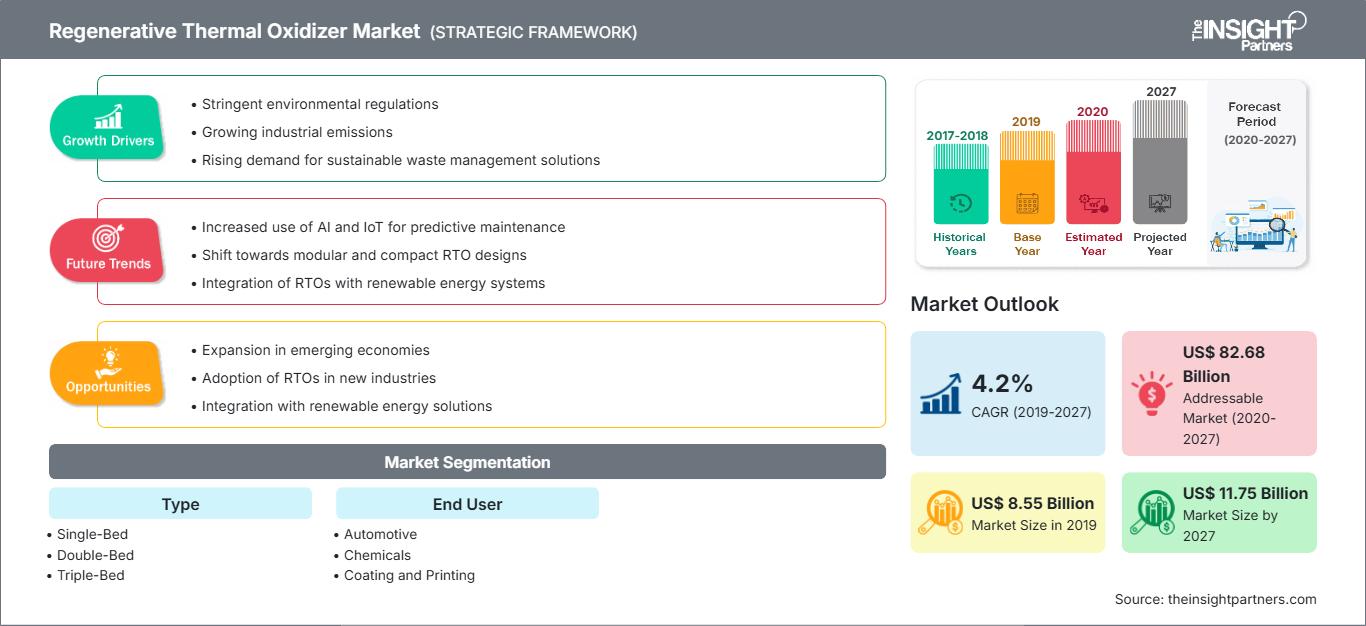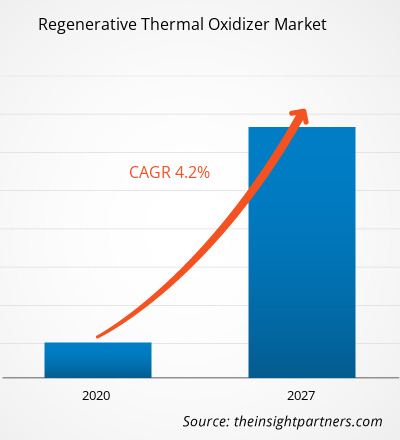Il mercato degli ossidatori termici rigenerativi (RTO) è stato valutato a 8,55 miliardi di dollari nel 2019 e si prevede che raggiungerà gli 11,75 miliardi di dollari entro il 2027; si prevede una crescita a un CAGR del 4,2% dal 2020 al 2027.
Le tecnologie di controllo dell'inquinamento atmosferico hanno un ampio campo di applicazione in diversi settori per la mitigazione degli inquinanti nocivi nell'atmosfera. Attualmente, numerosi prodotti chimici, precipitatori termici ed elettrostatici e scrubber, tra le altre offerte commerciali, sono ampiamente diffusi tra gli utilizzatori finali; questi prodotti sono comunemente forniti da diversi operatori che operano nel mercato degli ossidatori termici rigenerativi (RTO). Nonostante l'elevato costo degli RTO industriali, negli ultimi anni si è assistito a una loro adozione su larga scala. Fattori quali l'esistenza di severe linee guida normative e la crescente consapevolezza nei confronti dell'inquinamento ambientale e della sicurezza sul lavoro sono i principali fattori che hanno spinto la crescita del mercato negli ultimi anni.
Attualmente, il mercato globale degli ossidatori termici rigenerativi (RTO) comprende un numero significativo di operatori con focus regionale e un'offerta commerciale diversificata. Tuttavia, il mercato include anche un numero considerevole di operatori di fama mondiale, come Alliance Corporation, Anguil Environmental Systems, Inc., Catalytic Products International, Condorchem Envitech, Eisenmann SE, Filtracní Technika, Spol. sr.o., Shandong Baolan Environmental Protection Engineering Co., Ltd., Ship & Shore Environmental, Inc., Taikisha Ltd. e The CMM Group LLC. Inoltre, gli operatori di questo mercato offrono un'ampia gamma di soluzioni personalizzate, flessibili e robuste per gli ossidatori termici rigenerativi (RTO) per diversi settori industriali.
Il settore manifatturiero è tra i settori chiave che contribuiscono a una percentuale sostanziale dell'inquinamento atmosferico ogni anno. In relazione alle crescenti preoccupazioni relative al degrado ambientale e all'assottigliamento dello strato di ozono, causati da sostanze tossiche (HAP e COV) e gas emessi dalle industrie, i produttori si stanno concentrando fortemente sull'adozione di tecnologie avanzate per l'eliminazione delle sostanze tossiche e la riduzione delle emissioni nocive. Ciò sta generando una notevole domanda di RTO tra i produttori.
Personalizza questo rapporto in base alle tue esigenze
Potrai personalizzare gratuitamente qualsiasi rapporto, comprese parti di questo rapporto, o analisi a livello di paese, pacchetto dati Excel, oltre a usufruire di grandi offerte e sconti per start-up e università
Mercato degli ossidatori termici rigenerativi: Approfondimenti strategici

-
Ottieni le principali tendenze chiave del mercato di questo rapporto.Questo campione GRATUITO includerà l'analisi dei dati, che vanno dalle tendenze di mercato alle stime e alle previsioni.
L'attuale pandemia di COVID-19 continua a causare interruzioni a lungo termine in diversi importanti settori di processo e in settori specifici, tra cui l'automotive, la chimica, la produzione generale, l'elettricità e l'elettronica e il settore farmaceutico. Tuttavia, i settori critici come quello alimentare e delle bevande, farmaceutico, della produzione di energia e chimico hanno registrato interruzioni limitate durante la pandemia in diverse economie, a causa della loro importanza nei servizi di pubblica utilità e nelle forniture essenziali. Di conseguenza, la diffusione del lockdown a livello nazionale per ridurre al minimo la trasmissione del virus ha interrotto significativamente le attività della catena di approvvigionamento e la produzione di componenti, apparecchiature, controller e materie prime per le soluzioni di ossidatori termici rigenerativi (RTO) presso diversi produttori, in particolare le piccole e medie imprese. Inoltre, si prevede che le limitate attività produttive, insieme alla diminuzione della domanda da parte delle industrie utilizzatrici finali, ridurranno il fatturato complessivo del mercato nel corso del 2020, con conseguente calo della crescita del mercato nei prossimi anni.
Approfondimenti di mercato Aumento del volume di emissioni di sostanze tossiche
Il settore industriale globale ha registrato una crescita significativa nell'ultimo decennio. L'industrializzazione nei paesi sviluppati del Nord America e dell'Europa è principalmente attribuita alla solidità delle economie e al sostegno governativo. Il settore manifatturiero contribuisce in modo significativo al PIL dei rispettivi paesi, motivo per cui i governi dei paesi sviluppati stanno fortemente enfatizzando lo sviluppo del settore manifatturiero nei rispettivi paesi. Le unità produttive di settori come quello automobilistico, chimico, farmaceutico, petrolchimico, termoelettrico, nucleare, aerospaziale, del rivestimento e della stampa emettono enormi volumi di HAP e COV dai gas di scarico, con conseguente grave inquinamento ambientale. Per distruggere e sopprimere le emissioni di HAP e COV, diversi sviluppatori di tecnologie e sistemi industriali offrono RTO per diverse configurazioni industriali.
Approfondimenti di mercato basati sulla tipologia
In base alla tipologia, il mercato globale degli ossidatori termici rigenerativi è segmentato in ossidatori termici rigenerativi a letto singolo, ossidatori termici rigenerativi a letto doppio e ossidatori termici rigenerativi a letto triplo. Aziende come il Gruppo Dürr offrono DürrMegtecVocsidizer, un ossidatore termico rigenerativo (RTO) a letto singolo e senza fiamma con un design modulare; garantisce bassi costi di gestione per l'abbattimento dei COV e il controllo degli HAP. Il sistema garantisce un'elevata distruzione dei COV, con affidabilità, design semplice e un'efficienza energetica superiore. I modelli a letto doppio sono quelli con la maggiore richiesta di ossidatori termici rigenerativi. Quando questi progetti vengono utilizzati in combinazione con una valvola a fungo ben progettata, un sistema con letto ceramico a 2 camere diventa più efficiente e compatto. Oltre al design peculiare, questi RTO richiedono meno materiali e sono meno costosi da produrre.
Approfondimenti di mercato basati sull'utente finale
In base all'utente finale, il mercato degli ossidatori termici rigenerativi è segmentato nei settori automobilistico, chimico, dei rivestimenti e della stampa, farmaceutico, alimentare e delle bevande, dei semiconduttori e altri. Il controllo dell'inquinamento atmosferico è una preoccupazione comune nell'industria chimica a causa della crescente severità delle normative sulle emissioni. Pertanto, la necessità di disporre di soluzioni avanzate per il trattamento biologico, termico e chimico dei rifiuti sta guadagnando sempre più terreno. Durante la produzione di prodotti chimici, vengono prodotte diverse sostanze inorganiche corrosive e tossiche che richiedono un lavaggio prima dell'ossidazione. Pertanto, la domanda di scrubber e ossidatori nell'industria chimica per il trattamento delle emissioni di gas chimici e dei prodotti corrosivi è in forte aumento. Ciò stimola la crescita del mercato degli ossidanti termici rigenerativi per l'industria chimica.
Le iniziative di mercato sono le strategie comunemente adottate dalle aziende per espandere il proprio portafoglio prodotti. CPI è uno dei principali attori che implementano queste strategie per ampliare la base clienti e acquisire una quota significativa nel mercato degli ossidanti termici rigenerativi, il che a sua volta le consente di mantenere il proprio marchio nel mercato globale degli ossidanti termici rigenerativi.
2020: CPI ha installato un ossidante termico rigenerativo (RTO) Triton-II-2.95 da 2.000 SCFM per controllare le emissioni di COV da sei sfiati di serbatoi in uno stabilimento. Inoltre, l'azienda ha installato anche un doppio eliminatore di nebbia per regolare le emissioni di particelle inorganiche submicroniche provenienti da un processo di sfiato di serbatoi prima del passaggio all'RTO.
2019: CPI ha installato un ossidante termico rigenerativo (RTO) con +99% di DRE presso il rivestimento a nastro del nord-est degli Stati Uniti per la distruzione di COV e HAP. L'ossidatore termico rigenerativo (RTO) Triton II-60.97 da 60.000 SCFM regolerà le emissioni di HAP e COV da tre linee di rivestimento a nastro e relativi forni presso l'impianto.
2016: Le principali aziende petrolchimiche in Cina hanno richiesto di ridurre le emissioni di COV dall'impianto di acido tereftalico purificato (PTA). Acetato di metile, xilene, benzene, bromuro di metile, metanolo e CO erano solo alcune delle emissioni causate dal processo di produzione presso l'impianto. L'azienda ha installato un ossidatore termico rigenerativo (RTO) da 22.500 SCFM a 3 contenitori, con una distruzione del 99% dei COV e un recupero di energia termica (TER) del 95%.
Mercato degli ossidatori termici rigenerativiLe tendenze regionali e i fattori che influenzano il mercato degli ossidatori termici rigenerativi durante il periodo di previsione sono stati ampiamente spiegati dagli analisti di The Insight Partners. Questa sezione illustra anche i segmenti e la geografia del mercato degli ossidatori termici rigenerativi in Nord America, Europa, Asia-Pacifico, Medio Oriente e Africa, America meridionale e centrale.
Ambito del rapporto di mercato dell'ossidatore termico rigenerativo
| Attributo del rapporto | Dettagli |
|---|---|
| Dimensioni del mercato in 2019 | US$ 8.55 Billion |
| Dimensioni del mercato per 2027 | US$ 11.75 Billion |
| CAGR globale (2019 - 2027) | 4.2% |
| Dati storici | 2017-2018 |
| Periodo di previsione | 2020-2027 |
| Segmenti coperti |
By Tipologia
|
| Regioni e paesi coperti |
Nord America
|
| Leader di mercato e profili aziendali chiave |
|
Densità degli operatori del mercato degli ossidatori termici rigenerativi: comprendere il suo impatto sulle dinamiche aziendali
Il mercato degli ossidatori termici rigenerativi è in rapida crescita, trainato dalla crescente domanda degli utenti finali, dovuta a fattori quali l'evoluzione delle preferenze dei consumatori, i progressi tecnologici e una maggiore consapevolezza dei vantaggi del prodotto. Con l'aumento della domanda, le aziende stanno ampliando la propria offerta, innovando per soddisfare le esigenze dei consumatori e sfruttando le tendenze emergenti, alimentando ulteriormente la crescita del mercato.

- Ottieni il Mercato degli ossidatori termici rigenerativi Panoramica dei principali attori chiave
- Letto singolo
- Letto doppio
- Letto triplo
Per utente finale
- Automotive
- Prodotti chimici
- Rivestimento e stampa
- Prodotti farmaceutici
- Semiconduttori
- Altri
Per area geografica
-
Nord America
- Stati Uniti
- Canada
- Messico
-
Europa
- Regno Unito
- Germania
- Francia
- Italia
- Russia
- Resto d'Europa
-
Asia-Pacifico (APAC)
- Cina
- Giappone
- India
- Australia
- Corea del Sud
- Resto dell'APAC
-
Medio Oriente e Africa (MEA)
- Arabia Saudita
- Emirati Arabi Uniti
- Sudafrica
- Resto del MEA
-
Sud America (SAM)
- Brasile
- Argentina
- Resto del SAM
Profili aziendali
- Alliance Corporation
- Anguil Environmental Science
- Catalytic Products International
- CondorchemEnvitech
- Eisemann SE
- Filtračnítechnikaspol. s ro
- Ship and Shore Environmental, Inc.
- Shandong Baolan Environmental Protection Engineering Co., Ltd
- THE CMM GROUP, LLC
- Taikisha Ltd
- Analisi storica (2 anni), anno base, previsione (7 anni) con CAGR
- Analisi PEST e SWOT
- Valore/volume delle dimensioni del mercato - Globale, Regionale, Nazionale
- Industria e panorama competitivo
- Set di dati Excel
Report recenti
Testimonianze
Motivo dell'acquisto
- Processo decisionale informato
- Comprensione delle dinamiche di mercato
- Analisi competitiva
- Analisi dei clienti
- Previsioni di mercato
- Mitigazione del rischio
- Pianificazione strategica
- Giustificazione degli investimenti
- Identificazione dei mercati emergenti
- Miglioramento delle strategie di marketing
- Aumento dell'efficienza operativa
- Allineamento alle tendenze normative






















 Ottieni un campione gratuito per - Mercato degli ossidatori termici rigenerativi
Ottieni un campione gratuito per - Mercato degli ossidatori termici rigenerativi